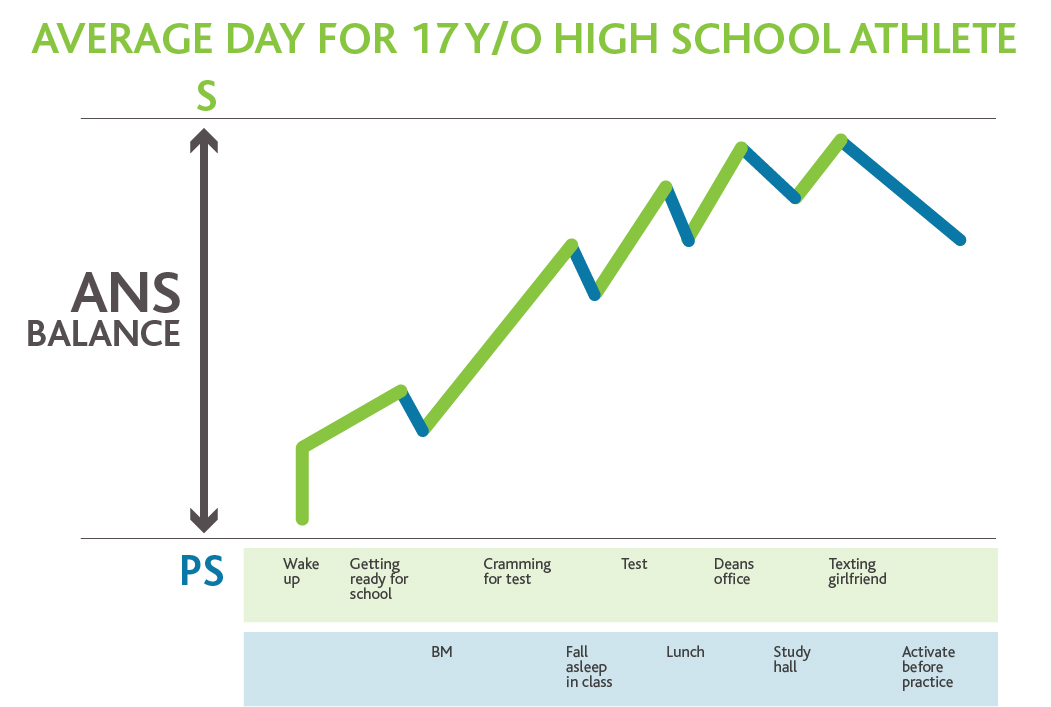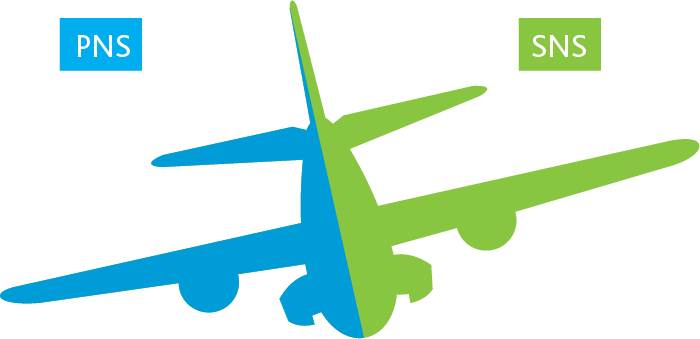Here’s an example of a day in the life of a high-school athlete. Some events are stressful – they activate the “fight or flight” part of your nervous system. Others are calming – they activate “rest and digest” part of your nervous system.
Guess which one happens more?

I’ve graphed the day’s events in terms of effects on the autonomic nervous system, or ANS. Events that activate the sympathetic wing of the ANS lead to upward movement. Events that activate the parasympathetic wing of the ANS lead to downward movement.
For most of us, on most days, the ANS is stimulated a lot more in the “S” direction than in the “P” direction. Life is stressful! And spending all that time in “fight or flight” mode leaves your nervous system out of balance.
Like wings on an airplane, the sympathetic and parasympathetic wings of the ANS should be contributing about equally to keep you in a healthy place. But most of us are flying more like the picture below.

Favoring your SNS doesn’t just wreck your ability to focus and perform. Over time, it can lead to conditions like high blood pressure, Irritable Bowel Syndrome, chronic pain, and mood disorders.
Fortunately, there are ways to activate the PNS and bring us back into balance. Yawning, meditation, and positive emotion and mindfulness exercises are a few. But my favorite is even simpler and more basic than that.
It’s called diaphragmatic breathing, and it’s your automatic key to your autonomic nervous system.
Meet your nervous system

Your nervous system consists of two smaller systems: the central and peripheral nervous systems. And your peripheral nervous system, at right, can be further split into the autonomic and somatic nervous systems. The way you breathe has an impact on both these regions, but it’s the autonomic nervous system (ANS) I want to focus on for now.
As you can see below, the ANS is the automatic connection between our internal organs and glands, and our central nervous system. It’s the link between your brain and a lot of what’s going on inside you. Your ANS is maintaining the balance in vital functions such as breathing, heartbeat, glandular secretions, salivation, and perspiration.

Understanding the structure of the ANS helps us understand how it works. Your ANS can be split into two divisions: the sympathetic division and the parasympathetic division. The first gets you riled up; the second gets you calmed back down. But you need them both to work in tandem.
The sympathetic nervous system, on the right side of the chart, connects to nerves all up and down the spinal cord. That extensive branching of nerves allows your ANS to mobilize multiple organs quickly and simultaneously. But the parasympathetic nervous system, on the left, connects just to the top and bottom of the spinal cord with very little branching. It creates a slower and more direct regulation in the organs.
Breathing is the key
When you breathe, your ANS responds. If you take quick and shallow breaths you activate your sympathetic nerves, telling your body that it’s time for quick reactions. If you take slow and deep breaths, pulling oxygen all the way down into your core, you activate your parasympathetic nerves. You tell your body that it’s time to calm down, get centered and start paying attention. Intentional and deep breathing,
And that’s just what happens when you breathe the Be Activated way. Your focused breathing actually activates the parasympathetic division. You bring your nervous system back to equilibrium.
Balanced athletes are better athletes
A lot of coaches don’t see the value of parasympathetic activation right away. After all, we’ve been conditioned to think that athletic performance is about getting “psyched up”, wired on adrenalin and as highly stimulated as we can be.
Parts of it certainly are. But most athletes – in fact, most human beings – don’t need more sympathetic activation. We spend our days living the graph at the beginning of this article. What we need is better ANS balance.
Balanced athletes focus. Balanced athletes pay attention. Balanced players hit their marks, make plays and have the presence of mind to spot that hole in the opposing team’s offensive line.
And the unbalanced athletes never see it coming…










